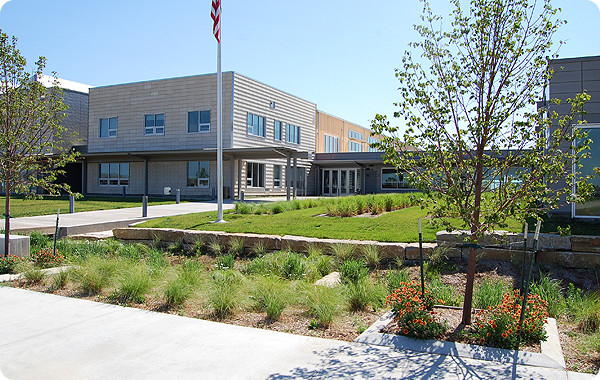Disaster Resiliency and Recovery Example Project: Greensburg, Kansas

The new LEED Platinum K-12 school in Greensburg, Kansas.
On May 4, 2007, a tornado destroyed or damaged 95% of the homes and businesses in the town of Greensburg, Kansas. Greensburg turned disaster into opportunity and created a plan to rebuild as a sustainable community with the help of a diverse group of experts, including the U.S. Department of Energy (DOE) and NREL.
DOE and NREL experts worked with city leaders, business owners, non-profit organizations, residents, and other state, federal, and local agencies to identify ways to incorporate energy efficiency and renewable energy technologies into the town's rebuilding efforts.
High-Performance Buildings
Through energy modeling, education, training, and onsite assistance, DOE and NREL helped Greensburg set and achieve aggressive energy efficiency goals for buildings. Thirteen new or renovated commercial buildings in Greensburg are saving a combined total of $200,000 in energy costs per year by incorporating energy efficiency and renewable energy technologies.
To date, Greensburg's per-capita ratio of U.S. Green Building Council Leadership in Energy & Environmental Design (LEED®) certified buildings is one per approximately every 129 citizens. In a town of 900 people, Greensburg currently has the highest per-capita concentration of LEED buildings in the United States.
Wind Power
In addition to building "green," DOE and NREL provided resource analysis, feasibility studies, and business plans to show Greensburg how it could meet its commitment to rely as much as possible on locally generated wind power. The Greensburg Wind Farm consists of 10 1.25-megawatt (MW) wind turbines that supply 12.5 MW of renewable power to the town—enough to power every house, business, and municipal building in Greensburg.
The town uses only about one-quarter to one-third of the power generated to reach its "100% renewable energy, 100% of the time" goal. Excess power is returned to the grid and offered as renewable energy credits for other Kansas Power Pool and NativeEnergy customers.
Back to Resilient Energy Systems home page.
Share
